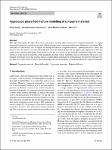Item Infomation
Full metadata record
| DC Field | Value | Language |
|---|---|---|
| dc.contributor.author | Kit, Au-Yeung | - |
| dc.contributor.author | Adria, Quintanas-Corominas | - |
| dc.contributor.author | Emilio, Martínez-Pañeda | - |
| dc.date.accessioned | 2023-04-27T07:24:12Z | - |
| dc.date.available | 2023-04-27T07:24:12Z | - |
| dc.date.issued | 2023 | - |
| dc.identifier.uri | https://link.springer.com/article/10.1007/s00366-023-01820-z | - |
| dc.identifier.uri | https://dlib.phenikaa-uni.edu.vn/handle/PNK/8355 | - |
| dc.description | CC BY | vi |
| dc.description.abstract | This paper investigates the effect of moisture content upon the degradation behaviour of composite materials. A coupled phase field framework considering moisture diffusion, hygroscopic expansion, and fracture behaviour is developed. This multi-physics framework is used to explore the damage evolution of composite materials, spanning the micro-, meso- and macro-scales. The micro-scale unit-cell model shows how the mismatch between the hygroscopic expansion of fibre and matrix leads to interface debonding. From the meso-scale ply-level model, we learn that the distribution of fibres has a minor influence on the material properties, while increasing moisture content facilitates interface debonding. The macro-scale laminate-level model shows that moisture induces a higher degree of damage on the longitudinal ply relative to the transverse ply. | vi |
| dc.language.iso | en | vi |
| dc.publisher | Springer | vi |
| dc.subject | composite materials | vi |
| dc.subject | Hygroscopic phase | vi |
| dc.title | Hygroscopic phase field fracture modelling of composite materials | vi |
| dc.type | Book | vi |
| Appears in Collections | ||
| OER - Công nghệ thông tin | ||
Files in This Item:

